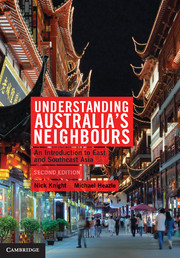Book contents
- Frontmatter
- Contents
- List of Maps
- Acronyms and abbreviations
- Acknowledgments
- Maps
- Introduction
- 1 The idea of ‘Asia’
- 2 Tradition and modernity in East and Southeast Asia
- 3 Tradition and modernity in East and Southeast Asia
- 4 Colonialism in East and Southeast Asia
- 5 Nationalism and revolution in East and Southeast Asia
- 6 Nations and nation-building in East and Southeast Asia
- 7 International politics and East and Southeast Asia
- 8 Economic growth in East and Southeast Asia
- 9 Democracy, human rights and development
- 10 Globalisation and East and Southeast Asia
- 11 China–Japan relations and US power in the twenty-first century
- 12 Australia in Asia, ‘Asia’ in Australia
- Bibliography
- Index
- References
8 - Economic growth in East and Southeast Asia
The Japanese economic ‘miracle’ and the newly industrialised economies
Published online by Cambridge University Press: 05 June 2012
- Frontmatter
- Contents
- List of Maps
- Acronyms and abbreviations
- Acknowledgments
- Maps
- Introduction
- 1 The idea of ‘Asia’
- 2 Tradition and modernity in East and Southeast Asia
- 3 Tradition and modernity in East and Southeast Asia
- 4 Colonialism in East and Southeast Asia
- 5 Nationalism and revolution in East and Southeast Asia
- 6 Nations and nation-building in East and Southeast Asia
- 7 International politics and East and Southeast Asia
- 8 Economic growth in East and Southeast Asia
- 9 Democracy, human rights and development
- 10 Globalisation and East and Southeast Asia
- 11 China–Japan relations and US power in the twenty-first century
- 12 Australia in Asia, ‘Asia’ in Australia
- Bibliography
- Index
- References
Summary
WHILE THE CASE FOR STUDYING Asia and Asian languages should not rest on a purely economic foundation, as some have argued (Garnaut 1989: chapter 15; East Asia Analytical Unit 1992), there are persuasive economic reasons for taking an interest in East and Southeast Asia, particularly from an Australian perspective. Australia's resource-based economy has considerable complementarity with the manufacturing economies of the region, and a close economic relationship has consequently been established, one that has brought both economic benefit and risk. Australia is both a buyer and seller in the markets of East and Southeast Asia. An increasing number of Australians either work in the region or do work in Australia that has a significant Asian content. The context within which Australian commerce and industry take place has increasingly become an Asian context. As Mark McGillivray pointed out more than a decade ago, ‘Australia on average more heavily depends on, and is more integrated economically (in so far as trade is concerned) with Asia than the rest of the world’ (1997: 63). It is, therefore, very important to know something about the economies of East and Southeast Asia, and how their prosperity has affected and influenced the Australian economy.
Japan's economic performance from the 1950s to the late 1980s demonstrated that an economy devastated by war and with few natural resources could achieve rapid economic growth. Its performance during the 1950s and 1960s was so impressive that some commentators described it as an economic ‘miracle’. But could this enviable economic growth be repeated elsewhere? Was there a latent dynamism in the other economies of East and Southeast Asia that could give rise to economic growth as spectacular as Japan's? From the mid-1960s, several economies in the region did in fact achieve impressive economic growth, actually surpassing Japan during the 1980s. These are described as the Newly Industrialising Economies (NIEs) (or Newly Industrialising Countries, NICs). The most successful of these NIEs – South Korea, Hong Kong, Taiwan, Singapore – have also been described as the ‘four little dragons’ (Vogel 1991), the ‘four tigers’ (World Bank 1993), and Asia's ‘miracle economies’ (Bello and Rosenfeld 1992; Woronoff 1986).
- Type
- Chapter
- Information
- Understanding Australia's NeighboursAn Introduction to East and Southeast Asia, pp. 137 - 160Publisher: Cambridge University PressPrint publication year: 2011



